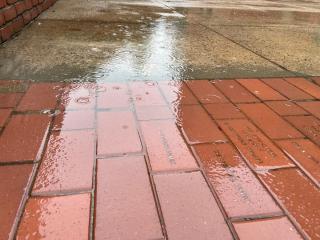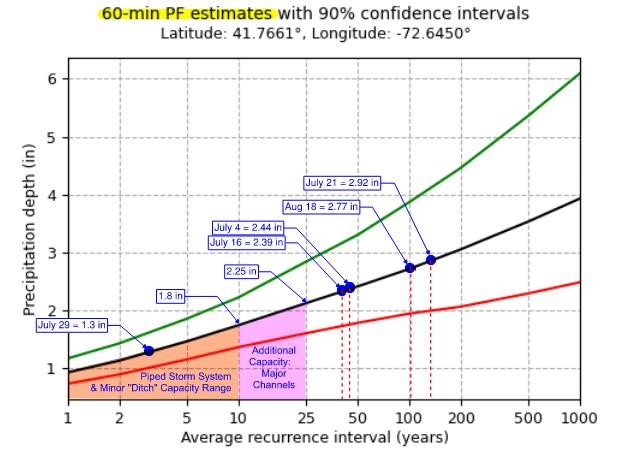Recent Localized Flooding in East Hartford

East Hartford, CT - Recent rainfall events in July, and now August, are raising questions about the storm drainage system in Town. Answers to some common questions are provided below:
Why is the storm drainage system not working? Why is my road now flooding?
In most cases, the Town’s storm drainage system is working, but the recent high intensity, short duration storm events are overwhelming the system. When runoff from a storm event exceeds the capacity of the storm drainage system, the whole system is full of water. Additional runoff is unable to enter the system and instead collects at the inlets (catch basins), fills low points in roads and overflows out of the roadway onto adjacent properties. For most of East Hartford, the capacity of the storm drainage system was established when residential subdivisions were developed. Piped storm drainage systems and minor “ditches” were required to convey 10-year storm runoff; major channels had to convey 25-year runoff. Three storms in July and one in August, to date, have exceeded that design capacity.
What does 10-year and 25-year runoff mean?
We never know just how much rain will fall in a storm event. We only know what historic rainfall events occurred. Based on the data, scientists make predictions about how much rain will fall. The predictions are described as a number of years of “return period”. When you invert a return period, you get the probability that a certain storm event will occur in any given year (e.g. 10-year return period = 10% chance of occurring in any year). The longer the return period, the less likely the storm (e.g. 25-year return period = 4% chance of occurring in any year). So, storm drain systems reach their design capacity when, per the historic rainfall records, the storm has less than a 10% (or 4%) chance of occurring in any given year.
How much rainfall does it take to exceed a 10- or 25-year return period?
The most important factor to now consider is the amount of time it takes for the rain to fall (a.k.a. the storm duration), which speaks to the intensity of the storm. The duration of the storm changes the amount of rainfall expected in a 10- or 25- year storm.
Imagine that 3 inches of rain falls during a storm over the course of a day (24 hours) – that intensity has a 2-year return period, meaning that it is very likely (50% probability in any given year) to occur. And, the storm drainage system is able to convey the runoff to the adjacent waterway without issue. If the same 3 inches of rain falls in a 3-hour period, then the return period is between 10- and 25-years and the system can still convey the runoff. But, if the 3 inches of rain falls in just an hour (60 minutes), the return period is approximately 184 years (0.54% of occurring in any given year) and the storm system is overwhelmed and localized flooding will occur.
What were the return periods of the major rainfall events in July (and now August)?
Based on observations by residents and Department of Public Works staff, it seems the four storms all occurred in about an hour. That means that the July 4 and July 16 rainfall were just under 50 year storms, the August 18 storm was a 100-year storm and the July 21 storm was almost a 150-year storm event. Using a graph provided by the National Ocean and Atmospheric Administration (NOAA), the storms line up like this:

In contrast to the four (4) high rainfall storms, the July 29 rainfall is less than 5-year event.
Why would stormwater system design be limited to a 10- or 25-year return period?
Municipalities use the 10- and 25-year storm event for the design of storm drainage systems as a minimum standard to ensure that runoff from the most frequent storm events are conveyed by the systems. Requiring higher return periods for design would raise the cost of the system which, in turn, increases the cost of the development and the cost of house lots in subdivisions. The 10- and 25-year designs are standard for most municipalities and the Connecticut Department of Transportation.
What will the Town do about the localized flooding?
The East Hartford Department of Public Works is evaluating localized flooding from these storms to determine if there are any blockages that are reducing the capacity of the storm drainage system. If found, blockages will be removed or pipes will be replaced to maintain system capacity. Minor improvements, like changing the type of catch basin top to increase capture capacity or providing other overflow relief, will be evaluated on a case-by-case basis. Longer-term solutions, like complete upgrade of a storm drainage system or a culvert replacement, require engineered analysis and design, which will be addressed when funding is available.
What can I do about flooding on my property?
Consider how your property is arranged and what you might be able to do to reduce your risk:
- Are you near a low point in the road?
- Where are catch basins located?
- If the storm drain system is overwhelmed, where would the excess runoff travel?
- Could your lawn be regraded to keep water away from a garage/basement/shed?
- Could you move a shed away from the area that would flood if the storm drainage system is overwhelmed?
If you chose to modify your property and it requires excavation or a piped connection, you should check with the Engineering Division (engineering@easthartfordct.gov or 860-291-7380) to see if a permit is required. Directing runoff toward (or away) from adjacent properties must be carefully reviewed to make sure there are no negative impacts on your neighbor’s property.
If you have a piped connection to the Town’s storm drainage system, consider a backflow preventer. You may need to switch to a pumped system to remove water instead of a piped (gravity) system.
You can also be a good observer when flooding occurs: take photos to document the level/extent and the time (including when rainfall starts and ends). The more information we have the better we can evaluate what is causing the flooding. Report localized flooding and upload photos to the Town’s QAlert system (https://easthartfordct.qscend.com/311/) using the Drainage/Flooding Issue request type.
References:

